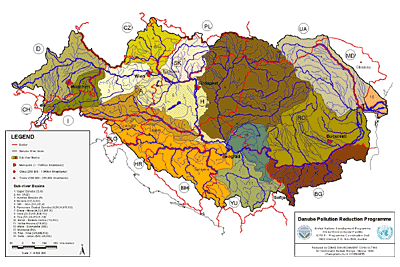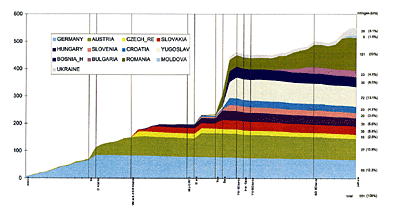After years of preparation, the EU Water Framework Directive finally came into force on December 22, 2000. It had been eagerly anticipated and will revolutionise water quality monitoring and water management practices. Some of the former EU directives such as the Fish Directive, the Shellfish Directive or the one on dangerous substances will be repealed within a few years since they have been integrated in this comprehensive "water framework".
In developing this new directive, the European Parliament and the Council of the European Union were guided by the fact that "water is not a commercial product like any other but, rather, a heritage, which must be protected, defended and treated as such." Waters in the Community are under increasing pressure from the continuous growth in demand for sufficient quantities of good quality water for all purposes.
The European Environment Agency in 1995 confirmed the need for action to protect community waters in qualitative as well as in quantitative terms and it was recognised that common principles were needed in order to co-ordinate the Member States' efforts to protect ecosystems and to promote sustainable water use.
The Water Framework Directive brings to water management practices major changes that go far beyond the current targets for water quality, emission control and water management.
Implementation in the Danube River Basin
What makes the implementation process in the Danube River Basin especially difficult is the fact that only Germany and Austria are currently EU members and
therefore obliged to comply with the Water Framework Directive. Most other Danube countries are accession countries that are now preparing to fulfil the complete body of EU legislation in order to become EU members. All Danube countries have agreed to make the necessary efforts to arrive at a co-ordinated international River Basin Management Plan for the Danube River Basin. Only one country honestly stated that this was dependent on the available financial means. It therefore becomes apparent that it is necessary to develop a realistic perspective of what can be achieved and how this can be done efficiently. In eight years, the Danube River Basin Management Plan will need to be reported to the European Commission.
One of the most difficult tasks in developing the Danube River Basin Management Plan is getting all Danube countries organised. The Danube River Basin is the second largest in Europe and has a total area of 817.000 km2. It includes territories of 18 countries. Some countries have only small portions of the river basin, but 13 countries have areas greater than 2000 km2. These have joined together to form the International Commission for the Protection of the Danube River (ICPDR) and have recently developed a Joint Action Programme defining short-term and long-term objectives (see article).
Sub-river basins versus sub-units
In the development of an implementation strategy for the development of a Danube River Basin Management Plan, the subdivision of the Danube River Basin into practical smaller working units has been a controversial issue. In the framework of the Danube Pollution Reduction Programme, a map of the sub-river basins in the catchment area was developed (see fig. 1). Some sub-basins are quite large by nature e.g. the Tisza River catchment covering areas of five countries. Other smaller catchments have been aggregated to form river basins of a tangible size. While the Water Framework Directive calls for the sub-river basin approach, some countries are proposing to use administrative districts instead. In some cases the river basin approach can interfere with federal and regional responsibilities and make changes in administrative competencies necessary. On the bilateral and multilateral level, the issues can become even more difficult and delicate.
 |
| Figure 1: Sub-basins in the Danbue River Basin |
In spite of the difficulties involved in its application, the river basin approach makes sense in the long-term. For downstream countries it is important to know what is happening upstream. A fishpond owner, for example, will want to know why the stream water is affecting his fish. On a large scale, an effective and coherent water policy must also take account of the vulnerability of aquatic ecosystems located near the coast and estuaries or in gulfs or relatively closed seas, as their equilibrium is strongly influenced by the quality of inland waters flowing into them. This is a particularly important issue in the Danube River Basin, since the eutrophication of the Black Sea is strongly influenced by the high nutrient load of the Danube River (see Figure 2). In terms of an effective and sustainable water resources management it will be essential to view all impacts and pressures in the context of the whole river basin and to know its peculiarities in order to find the most effective remediation measures.
 |
| Figure 2: Annual nitrogen load in the Danube (in kt/y) by country of origin with a high estimate for in-stream denitrification. |
Adhering to a tight time schedule
In line with the general objectives of the Joint Action Programme and guided by the requirements and in particular the reporting deadlines set by the Water Framework Directive, a work plan has been developed within the ICPDR identifying the necessary steps until 2004. Some of the urgent tasks include:
- Definition of the Danube River Basin District and its sub-river basins for surface water bodies including coastal waters and for groundwater,
- Development of maps and GIS,
- Definition of typology and reference conditions for surface water bodies,
- Identification of artificial and heavily modified water bodies,
- Identification and assessment of pressures and impact on surface water bodies from point and diffuse sources,
- Review and analysis of causes and effects from human activities on groundwater bodies from point and diffuse sources.
Completing these tasks will require a joint effort of all involved in the implementation process on the national level and within the ICPDR and financial support will be essential especially in the accession countries.
Support by the UNDP/GEF Danube Regional Project
The UNDP-GEF Danube Regional Project "Strengthening the Implementation Capacities for Nutrient Reduction and Transboundary Cooperation in the Danube River Basin" will start on December 1, 2001 (see article). 20 project components with a total of 80 activities have been planned. These will form a solid base for the implementation of a multitude of remedial measures in pollution and nutrient reduction.
The European Commission stipulates the use of a geographic information system (GIS) for the reporting of data. Therefore, an urgent task involves the development of a harmonised GIS for the Danube River Basin. National maps will be prepared by the countries according to agreed criteria, but one institute will have to piece these together to form the overview map. Appropriate funds could come from the GEF-project.
Outlook for the future
Important is that the countries get started with the implementation process. Quite a number of steps, particularly in the legal transposition into national law as well as in the coordination process within bilateral agreements have taken place. Germany has developed a guidebook for the implementation of the Water Framework Directive, which will serve as an orientation for the Danube countries. The English version of the guidebook was distributed to the Danube countries in June 2001 and is also available in the DANUBIS information system of the ICPDR (see article). In order to support the national activities, workshops are being organised to provide guidance as to the methodological approach. The workshops will identify specific issues in the Danube River Basin and report them to the respective working groups of the European Commission. This is a way to ensure that the specific problems of the Danube River Basin are dealt with at the European level and that a harmonised approach is achieved throughout Europe.
FOR INFORMATION
The Water Framework Directive stands out for
- setting uniform standards in water policy throughout the European Union and integrates different policy areas involving water issues;
- introducing the river basin approach for the development of integrated and co-ordinated river basin management plans for all European river systems;
- including public participation in the development of river basin management plans encouraging active involvement of interested parties including stakeholders, non-governmental organisations and citizens;
- stipulating a defined time-frame for the achievement of the good status of surface water and groundwater applying penalties if provisions are not adhered to;
- requesting a comprehensive ecological assessment and classification on the basis of the composition and abundance of the aquatic fauna and flora taking into account the type-specific reference conditions of the water body;
- introducing the economic analysis of water use in order to estimate the most cost-effective combination of measures in respect to water uses.